Effects of Different Cultivation Media and Periods on the Content of Main Active Components of Cordyceps militaris Strain QC04
2022-06-18ZHUSenlinZHANGQinyuCHENXu
ZHU Sen-lin, ZHANG Qin-yu, CHEN Xu
Guizhou Institute of Soil and Fertilizer, Guiyang 550006, PRC
Abstract In this study, Cordyceps militaris strain QC04 was cultivated in oat,rice, and wheat media for different time periods. We studied the effects of different cultivation media and periods on the fruiting body biomass and active components of C. militaris, aiming to provide reference for the production and utilization of C.militaris QC04. The results showed that the dry weight of the fruiting body of C.militaris was the highest in the wheat medium, moderate in the oat medium, and the lowest in the rice medium. The content of cordycepin and adenosine in the fruiting body and residual medium was higher in the oat and rice media than in the rice medium. The content of cordycepin and adenosine in fruiting body and residual medium peaked on day 55. Furthermore, the content of cordycepin in the fruiting body was lower than that in the residual medium, while the content of adenosine showed an opposite trend. The content of cordycepic acid in the rice medium was generally higher than that in the oat and wheat media. As the cultivation period extended, the fruiting body biomass declined and the content of cordycepic acid in the fruiting body increased slightly.
Key words Cordyceps militaris; Cultivation media; Cultivation periods; Active components
1. Introduction
Cordyceps militarisis a fungal species belonging to Clavicipitaceae,Hypocreales, Ascomycetes, Ascomycota[1], with high nutritional value and medicinal value[2-4]. Studies have demonstrated that the main active components ofC. militarisare similar to those ofCordyceps[5],including cordycepin, cordycepic acid, adenosine, and trace elements,which can enhance immunity, resist bacteria, mitigate inflammation,and protect health[6]. In recent years,C. militarisindustry has developed rapidly and been expanding. In 2009, China approvedC. militarisas a new food raw material[7-8]. In the current production ofC. militaris,farmers pursue high yield while ignoring the main active components and the nutritional and healthcare effects ofC. militaris[9]. In this study, the content of the main active components inC. militariscultivated under different conditions are investigated, which is of great significance to expand the development and application ofC. militarisproducts.
Cultivation medium is the basic material for the growth and development ofC. militaris, and cultivation period is a key factor affecting the content of active components in this fungus. The selection of cultivation medium and period affects the fruiting body biomass and the main component content.However, little is known about the effects of different cultivation media on the biomass and main active components ofC. militarisfruiting body. In this study,we compared the content of main active components inC. militarisQC04 cultivated in oat, rice and wheat media for different time periods, aiming to provide reference for increasing the content of active components and deepening the development and utilization ofC. militaris.
2. Materials and Methods
2.1. Experimental materials
2.1.1. Fungal strain
C. militarisQC04 was provided by the Laboratory of Edible Fungi, Guizhou Institute of Soil and Fertilizer.
2.1.2. Culture medium
Solid medium: potato 200 g/L, glucose 20 g/L,agar 18 g/L, KH2PO42 g/L, MgSO41 g/L, dissolved in water to reach 1 L.
Liquid medium: potato 200 g/L, glucose 20 g/L,yeast extract 5 g/L, fish meal peptone 2 g/L, KH2PO42 g/L, MgSO41 g/L, dissolved in water to reach 1 L.
Nutrient solution: glucose 20 g/L, peptone 5 g/L,KH2PO41 g/L, MgSO41 g/L, dissolved in water to reach 1 L.
Three treatments were designed, each with three parallels. The prepared medium was put into a 600 mL wide-mouth glass bottle. ① Rice medium: rice 30 g +nutrient solution 50 g;② Wheat medium: wheat 30 g +nutrient solution 50 g; ③ Oat medium: oat 30 g +nutrient solution 50 g.
2.1.3. Cultivation methods
C. militarisQC04 was activated on solid medium and then inoculated into liquid medium and cultivated at 20℃ and 120 r/min for 5 d. The obtained seed culture was inoculated in the liquid medium at a volume ratio of 1 ∶5. The diluted seed culture was then respectively inoculated into the three cultivation media and incubated first at 15℃ for 5 d and then at 20℃,the light intensity of 200 lx, and the relative humidity of 85%. After 35, 45, 55, and 65 d, the fruiting bodies and the residual media were harvested.
2.2. Determination of main indicators
2.2.1. Dry weights of fruiting body and residual medium
Constant temperature hot air drying method[10]was employed to determine the dry weights of fruiting body and residual medium. Specifically, the harvested fruiting bodies and residual media were placed in a constant temperature blast drying oven at 50℃ and dried to constant weight (dry weight). The average value of each treatment was calculated.
2.2.2. Contents of cordycepin and adenosine
The contents of cordycepin and adenosine was determined by high performance liquid chromatography according to the procedure in NY/T 2116-2010[11].
2.2.3. Content of cordycepic acid
The content of cordycepic acid was determined by spectrophotometry[12].
2.3. Data analysis
The experimental data were analyzed in SPSS 23.0.
3. Results and Analysis
3.1. Effects of different cultivation media and periods on dry weights of fruiting bodies and residual media
Table 1 showed the dry weights ofC. militarisfruiting bodies cultivated in different media for different time periods. The dry weight of fruiting body increased from day 35 to day 55, peaked on day 55,and declined on day 65. The dry weight on day 55 was higher than that on other days (P<0.05). Therefore,day 55 was the best time to harvest fruiting body for high yield. Although declined, the dry weight on day 65 was still significantly higher than that on days 35 and 45. The dry weight of fruiting body cultivated for the same time period varied among different media,being the highest in the wheat medium, moderate in the oat medium, and the lowest in the rice medium(P<0.05).
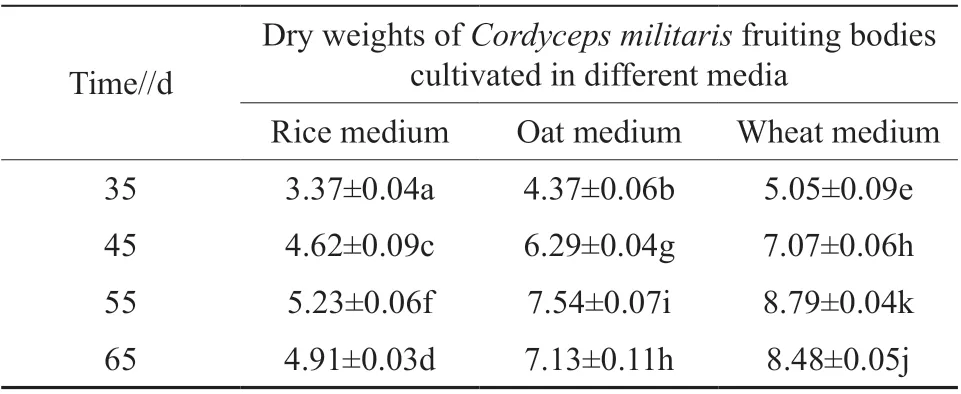
Table 1 Dry weights of Cordyceps militaris fruiting bodies cultivated in different media for different time periods g/bottle
Table 2 showed the dry weights of residual media after the cultivation for different time periods. The dry weight of the residues of the three media decreased from day 35 to day 45 (P<0.05). The dry weights of the residues of rice medium and wheat medium had no significant change after day 45. The dry weight of the oat medium residue decreased continuously until day 55 and showed no significant difference between days 55 and 65. The dry weight of residual medium was the highest in the oat medium, moderate in the rice medium, and the lowest in the wheat medium.Furthermore, the dry weights of the wheat medium residue on days 35 and 45 were higher than those on days 55 and 65. The dry weights of the residues ofoat medium and rice medium showed no significant difference and were higher than that of wheat medium(P<0.05).
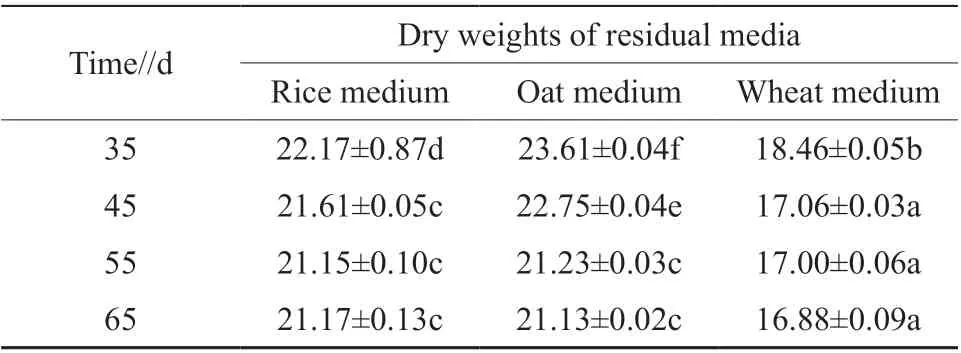
Table 2 Dry weights of residual media after cultivation for different time periods g/bottle
3.2. Effects of different cultivation media and periods on cordycepin content in fruiting bodies and residual media
The content of cordycepin in the fruiting bodies ofC. militariscultivated in different media for different time periods was shown in Table 3. The content of cordycepin in the fruiting body increased from day 35 to day 55 (P<0.05), peaked on day 55,and declined on day 65 (P<0.05). From day 35 to day 55, the content of cordycepin in the fruiting bodies was in a descending order oat medium>wheat medium>rice medium (P<0.05). On day 65, the order became wheat medium>oat medium>rice medium(P<0.05). The highest content of cordycepin in fruiting body appeared in oat medium on day 55. The content of cordycepin in the residual media after cultivation for different time periods was shown in Table 4. The content of cordycepin in the residual media increased from day 35 to day 55 (P<0.05) and declined on day 65. From day 35 to day 65, the content of cordycepin in residual media was the highest in the wheat medium, moderate in the oat medium, and the lowest in the rice medium (P<0.05). The highest content of cordycepin in residual medium appeared in wheat medium on day 55. The content of cordycepin in fruiting bodies was lower than that in residual media after cultivation for the same time (Tables 3 and 4).Moreover, the dry weight of residual medium was higher than that of fruiting body. Therefore, it was of higher commercial value to extract cordycepin from the residual medium. The content of cordycepin in oat medium and wheat medium was higher than that in rice medium. Moreover, the content of cordycepin in oat medium was significantly higher than that in wheat medium.
3.3. Effects of different cultivation media and periods on adenosine content in fruiting bodies and residual media
The adenosine content in the fruiting bodies ofC. militariscultivated in different media for different time periods was shown in Table 5. The adenosine content in the fruiting bodies increased significantly from day 35 to day 55 and decreased from day 55 to day 65 (P<0.05). The adenosine content in fruiting bodies from day 35 to day 65 was in a descending order of wheat medium>oat medium>rice medium(P<0.05), and the highest adenosine content in fruiting body appeared in wheat medium on day 55. The adenosine content in residual media after cultivation for different time periods was shown in Table 6.The adenosine content in residual media increased significantly from day 35 to day 55 (P<0.05) and then declined on day 65 (P<0.05). The content of adenosine in residual media was in a descending order of wheat medium>oat medium>rice medium (P<0.05) from day 35 to day 55, and the peak of adenosine content in residual medium appeared in wheat medium on day 55. The adenosine content in fruiting bodies was higher than that in residual media after cultivation for the same time period (Tables 5 and 6).
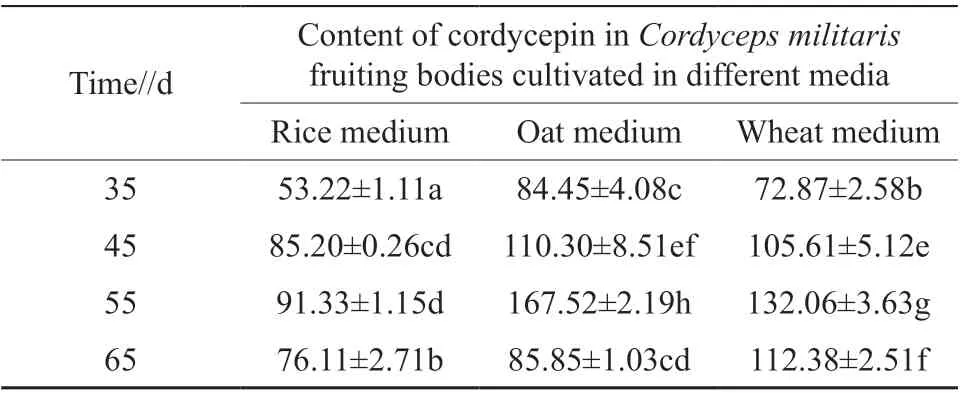
Table 3 Content of cordycepin in Cordyceps militaris fruiting bodies cultivated in different media for different time periods mg/100 g
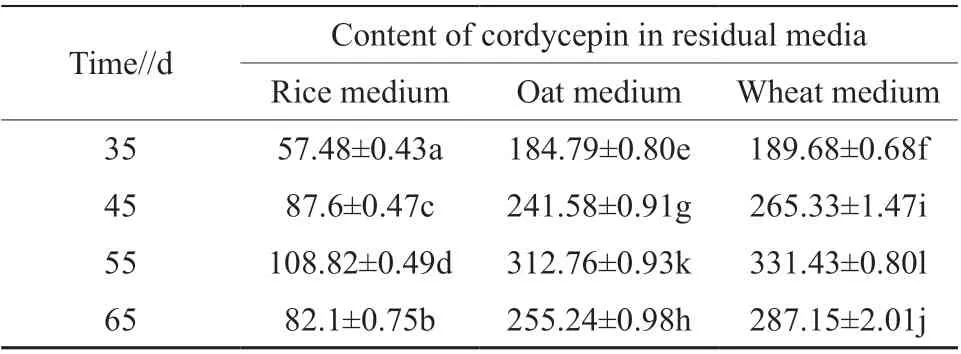
Table 4 Content of cordycepin in residual media aftercultivation for different time periods mg/100 g
3.4. Effects of different cultivation media and periods on cordycepic acid content in fruiting bodies and residual media
As shown in Table 7, the content of cordycepic acid in the fruiting bodies increased from day 35 today 65 (P<0.05), being the highest in the rice medium,moderate in the wheat medium, and the lowest in the oat medium (P<0.05). The highest content of cordycepic acid in fruiting body appeared in the rice medium on day 65, reaching 195.18 mg/100 g. As shown in Table 8, the content of cordycepic acid in the residual media increased from day 35 to day 55(P<0.05) and declined from day 55 to day 65. The highest content of cordycepic acid in residual medium appeared on day 55 in wheat medium. The content of cordycepic acid in residual media on days 35, 45, and 65 was in a descending order of rice medium>wheat medium>oat medium (P<0.05), while the order on day 55 was wheat medium>rice medium>oat medium(P<0.05). The content of cordycepic acid in fruiting bodies was higher than that in residual media after cultivation for the same time period (Tables 7 and 8).
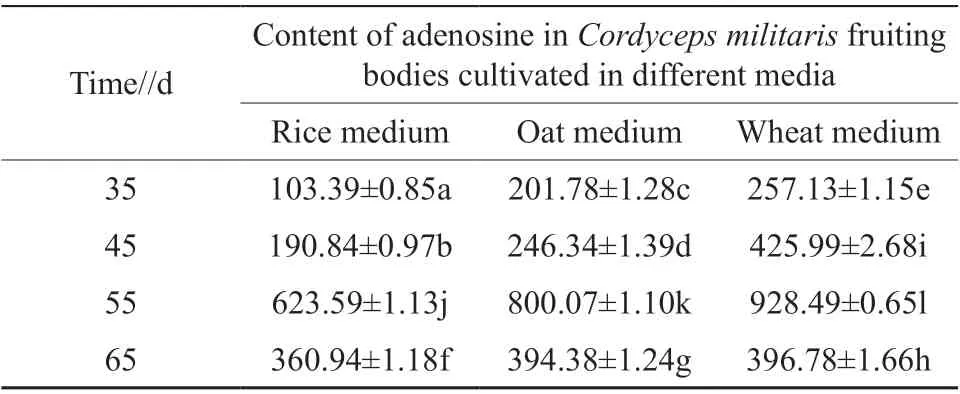
Table 5 Content of adenosine in Cordyceps militaris fruiting bodies cultivated in different media for different time periods mg/100 g
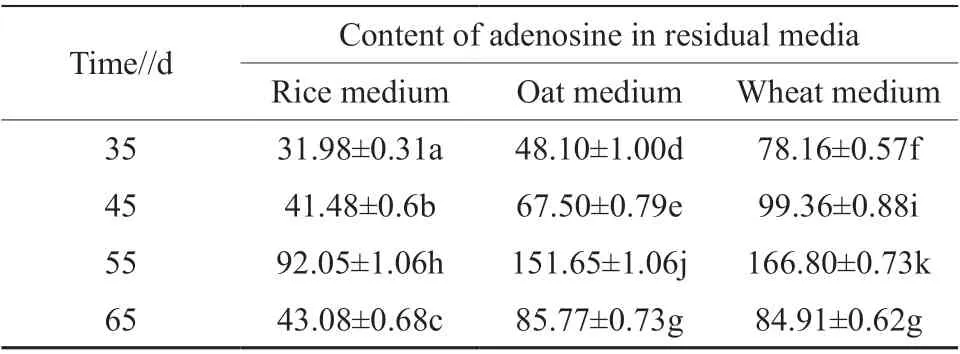
Table 6 Content of adenosine in residual media after cultivation for different time periods mg/100 g
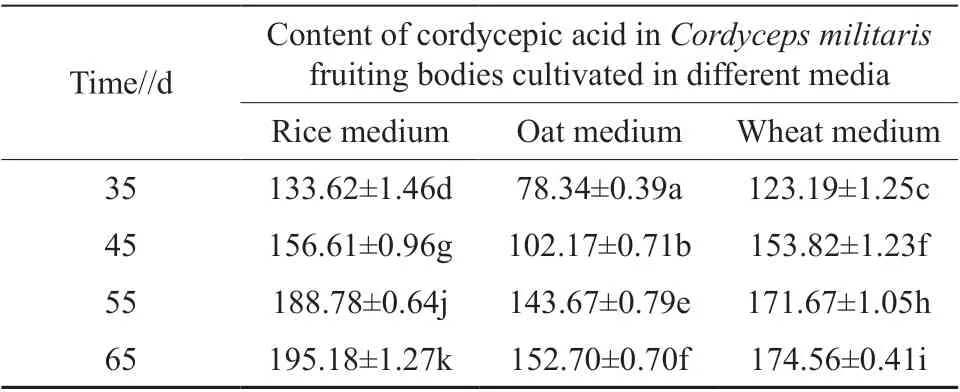
Table 7 Content of cordycepic acid in Cordyceps militaris fruiting bodies cultivated in different media for different time periods mg/100 g

Table 8 Content of cordycepic acid in residual media after cultivation for different time periods mg/100 g
4. Discussion and Conclusions
As people’s material life keeps improving,the demand for healthy food is increasing. While pursuing the high yield of fruiting bodies, more and moreC. militarisproduction enterprises put forward higher requirements for the content of main active components such as cordycepin and adenosine.Although the effects of cultivation media and periods on the growth and development ofC. militarishave been proved, little is known about the changes of main active components in the fruiting bodies and residual media after cultivation for different time periods. In this study,C. militarisQC04 was cultivated in oat,rice, and wheat media for different time periods, and then the content of active components in the fruiting bodies and residual media were compared. The results demonstrated that both fruiting body biomass and the content of active components in fruiting bodies and residual media varied among different cultivation media. The dry weight of fruiting body was the highest in the wheat medium, moderate in the oat medium, and the lowest in the rice medium after cultivation for the same time period, and peaked on day 55. This result was consistent with that obtained by YU R Let al.[13]. The content of cordycepin,cordycepic acid, and adenosine inC. militarisfruiting bodies varied among different media, which was consistent with the research conclusion of QIAN W Jet al.[14]. In addition, the content of cordycepin and adenosine in the fruiting bodies and the residues of oat and wheat media were higher than those of rice media after cultivation for the same time period. Therefore,oat and wheat media were suitable for increasing the content of active components inC. militaris. At the early stage of cultivation, the content of cordycepin and adenosine in fruiting bodies and residual media increased with the increase in fruiting body biomass,which was consistent with the conclusion of YU T Tet al.[15]. At the late stage of cultivation, the biomass declined, and the content of cordycepin and adenosine decreased accordingly. Therefore, day 55 was the best time to harvest fruiting bodies or residual media for obtaining high content of cordycepin and adenosine.Moreover, the content of cordycepin in the residual media was higher than that in the fruiting bodies,which may be because the over-mature hyphae in the medium were more conducive to the accumulation of the secondary metabolite cordycepin. Because the dry weight of residual medium was higher than that of fruiting body, extracting cordycepin from residual medium possessed a high commercial value.The adenosine content in the residual media was also higher than that in the fruiting bodies because adenosine was a primary metabolite essential for the growth and reproduction of the fungus. Moreover,the hyphae in the fruiting body had lower maturity and higher activity than those in the medium, so they tended to produce more adenosine. The content of cordycepic acid in rice medium was higher than that in oat and wheat media, and it increased a little when the fruiting body biomass declined at the late stage. The content of cordycepic acid in rice medium reached the highest on day 65. Therefore, it can be concluded that the cultivation medium and period should be determined considering the use of fruiting bodies.The results of this study provided reference for the application ofC. militarisQC04 and the development of protected cultivation techniques.
杂志排行
Agricultural Science & Technology的其它文章
- TIB for Micropropagation and the Relationship between Anthocyanins and Chlorophyll of Strawberry Seedlings
- Study on Weed Control and Safety of Tembotrione-Atrazine Tank Mixture in Spring Maize Fields
- Control Effects of Mixture of Metamifop and Cyhalofopbutyl on Annual Weeds Barnyard Grass in Directseeding Paddy Field
- Mechanism of Solid State Fermentation in Reducing Free Gossypol in Cottonseed Meal and the Effects on the Growth of Broiler Chickens
- Analysis on Interaction Effects Between Variety and Site of Silage Maize Regional Test in Guizhou Province
- Effects of Different Intercropping Patterns on Population Yield and Benefit of Fresh Maize and Mung Bean
